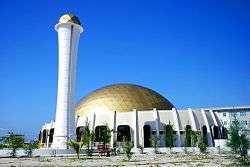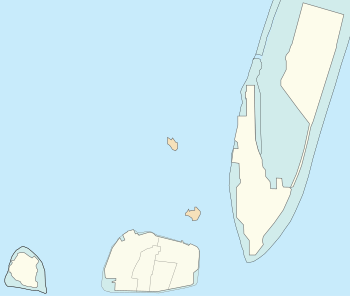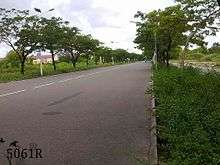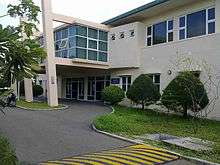Hulhumalé
| Hulhumalé ހުޅުމާލެ | |
|---|---|
| District of Malé | |
 Mosque of Hulhumalé | |
 Hulhumalé Location in Maldives | |
| Coordinates: 4°13′N 73°32′E / 4.217°N 73.533°ECoordinates: 4°13′N 73°32′E / 4.217°N 73.533°E | |
| Country | Maldives |
| Geographic atoll | North Male' Atoll |
| Government | |
| • Council | Malé City Council |
| Area | |
| • Total | 2 km2 (0.8 sq mi) |
| Dimensions | |
| • Length | 2.4 km (1.5 mi) |
| • Width | 1.0 km (0.6 mi) |
| Population | |
| • Total | 30,000 |
| • Density | 15,000/km2 (39,000/sq mi) |
| Time zone | UTC+05:00 (MST) |
Hulhumalé or Hulhulemale (Dhivehi: ހުޅުމާލެ) is a reclaimed island located in the south of North Male Atoll, Maldives. The artificial island was reclaimed to establish a new land mass required to meet the existing and future housing, industrial and commercial development demands of the Malé region. The official settlement was inaugurated by President Maumoon Abdul Gayoom on May 12, 2004.
The development and management of the island is undertaken by a government-owned corporation called Housing Development Corporation (formerly Hulhumalé Development Unit/Hulhumalé Development Corporation) which was incorporated on March 23, 2005.
Location within Malé City
Hulhulmalé is located northeast of airport island Hulhulé, to which it is connected by a causeway:

History
Reclamation of Hulhumalé began on October 16, 1997 on the Hulhulé-Farukolhufushi lagoon 1.3 km off the north west coast of Malé. Initial reclamation (or Phase I) consisting of 45% of land mass was carried out by the Ministry of Construction and Public Works (MCPW) costing USD 11 million. The project was then continued by a Belgian Joint Venture Company, International Port Engineering and Management (IPEM) and Dredging International (DI) costing an estimated USD 21 million. All the works involving reclamation and coastal structure development covered in Phase I were completed by June 2002.
Development

A basis of development known as Phase I was formed under the first Master Plan which was completed in July 2001 by a consortium of consultants from Singapore with the contribution of many government agencies, committees and individuals. It conceptually defines the long-term land use and development strategy (including urban design proposals, transportation plans and utility infrastructure) with considerations for future infrastructure connections to the adjacent Phase II and planned airport extension areas. The Master Plan is to be periodically reviewed and adjusted to include advances in development.
Phase I of the Master Plan includes:

Stage 1A (completed)
- A 280-room apartment complex with a combination of 2,3 and 4 bedroom units
- An integrated primary and secondary school housing 20 classrooms
- A public building for government and social requirements containing 32 units
- A hospital with 50 bed capacity
- A mosque for 1500 persons
- Four commercial buildings with a total of 48 units
- An asphalt-paved road network approximately 12.5 km long
- An adequate land space for the cultivation of indigenous plants and imported varieties
Stage 1B (to be completed by December 2005)
- 232 condominium housing units
- 120 basic housing units
- 169 beach plots
- 56 Standard plots,
- 132 terraced houses
- 280 housing units
- 57 residential beach front plots
- 109 residential beach plots
- 56 residential standard plots
- 132 plots for terraced housing
- A public building with 32 public units
- 15 industrial and commercial land plots with an average of 1,000 m2 per unit
Stage 1C (planned for 2006)
- 1900 housing units
Stage 2 (targeted for 2016)
- 2950 housing units
Stage 3 (targeted for 2020)
- 3075 housing units
Hulhumalé is underutilized relative to other central atolls in the Maldives. It would take the lead of the government to improve utilization by moving government ministers, government departments and public institutions to Hulhumalé and assisting public servants with relocation costs. Pending urban development, greenery landscaping would help make the place more attractive.
On 15 January 2015 the second reclamation phase of Hulhumalé was launched,[1] which will include the construction of a Youth Centre.[2]
Transport
Hulhumalé has road network which was planned together with the development of the island. The network covers the entire island and support all types of road vehicles.
The island is connected via a causeway to the airport island Hulhulé Island, allowing road transport to easily travel between the airport and Hulhumalé. With the opening of the Sinamalé Bridge between Hulhulé and Malé Island in September 2018,[3] the road networks of the three islands were connected for the first time.
External links
References
- ↑ http://minivannews.com/politics/president-yameen-calls-on-youth-to-relocate-to-hulhumale-92174
- ↑ http://isles.egov.mv/Island/IslandProjects.aspx?lid=2&tid=1&id=434 Isles: Hulhumale' Projects
- ↑ http://maldivesindependent.com/business/china-maldives-friendship-bridge-project-launched-121081 “China-Maldives Friendship Bridge” project launched